Sustainable Systems: Environmental Impact Assessment in Australia
VerifiedAdded on 2023/06/05
|15
|3284
|268
Report
AI Summary
This report examines sustainable systems and their role in addressing challenges arising from peak oil, focusing on Australia's strategies to mitigate limitations to growth. It details the steps required for project approval involving Environmental Impact Assessment (EIA) in New South Wales, highlighting how practitioners overcome pitfalls in the EIA process. The report further discusses development activities for conducting EIA, specifically addressing road congestion and energy demand. Soft tools and strategies for controlling congestion are explored, emphasizing the importance of sustainable measures such as reducing, recycling, reusing, and recovering resources. The analysis includes the integration of ecologically sustainable policies, stakeholder involvement, and technological advancements to improve transportation and reduce environmental impact, aiming for balanced economic, social, and environmental outcomes.
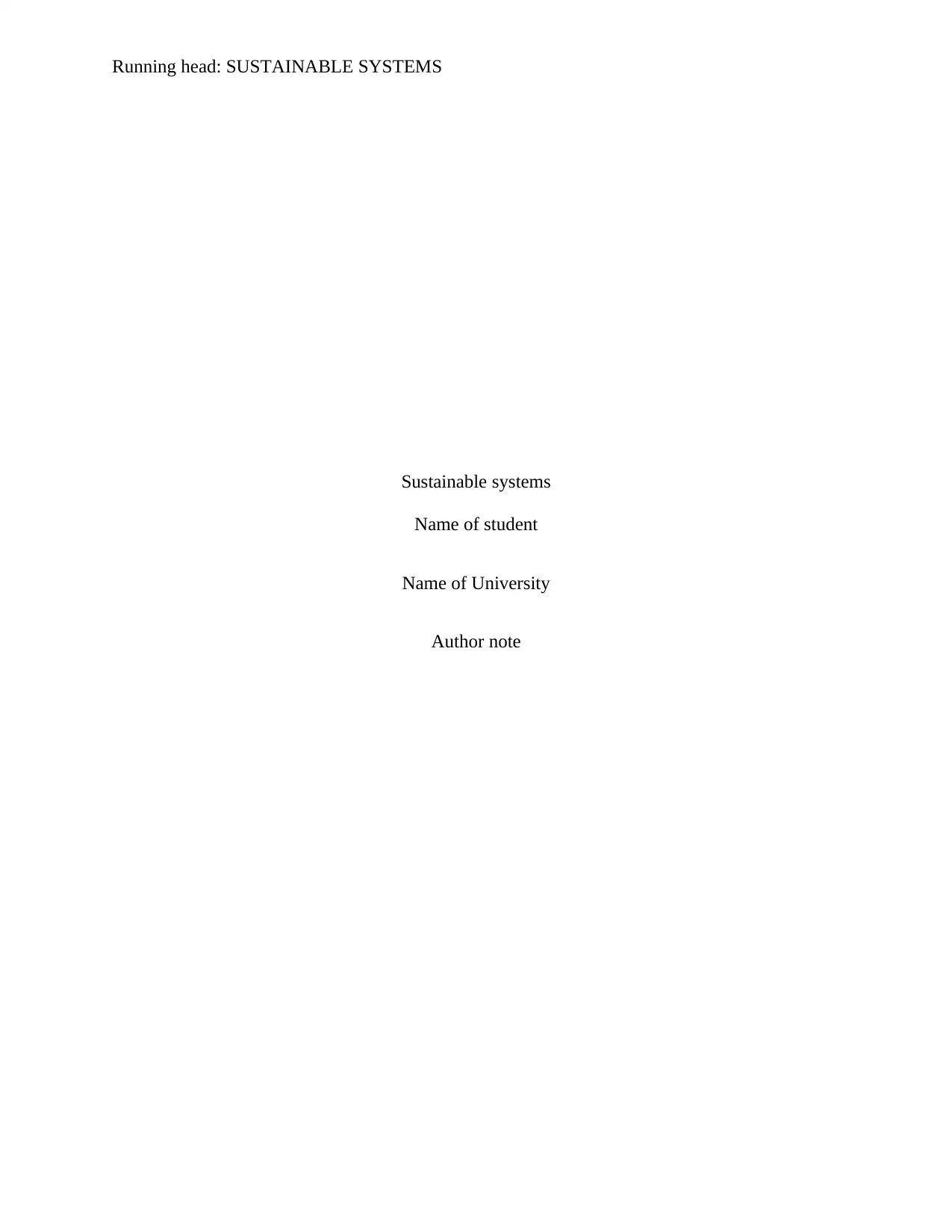
Running head: SUSTAINABLE SYSTEMS
Sustainable systems
Name of student
Name of University
Author note
Sustainable systems
Name of student
Name of University
Author note
Paraphrase This Document
Need a fresh take? Get an instant paraphrase of this document with our AI Paraphraser
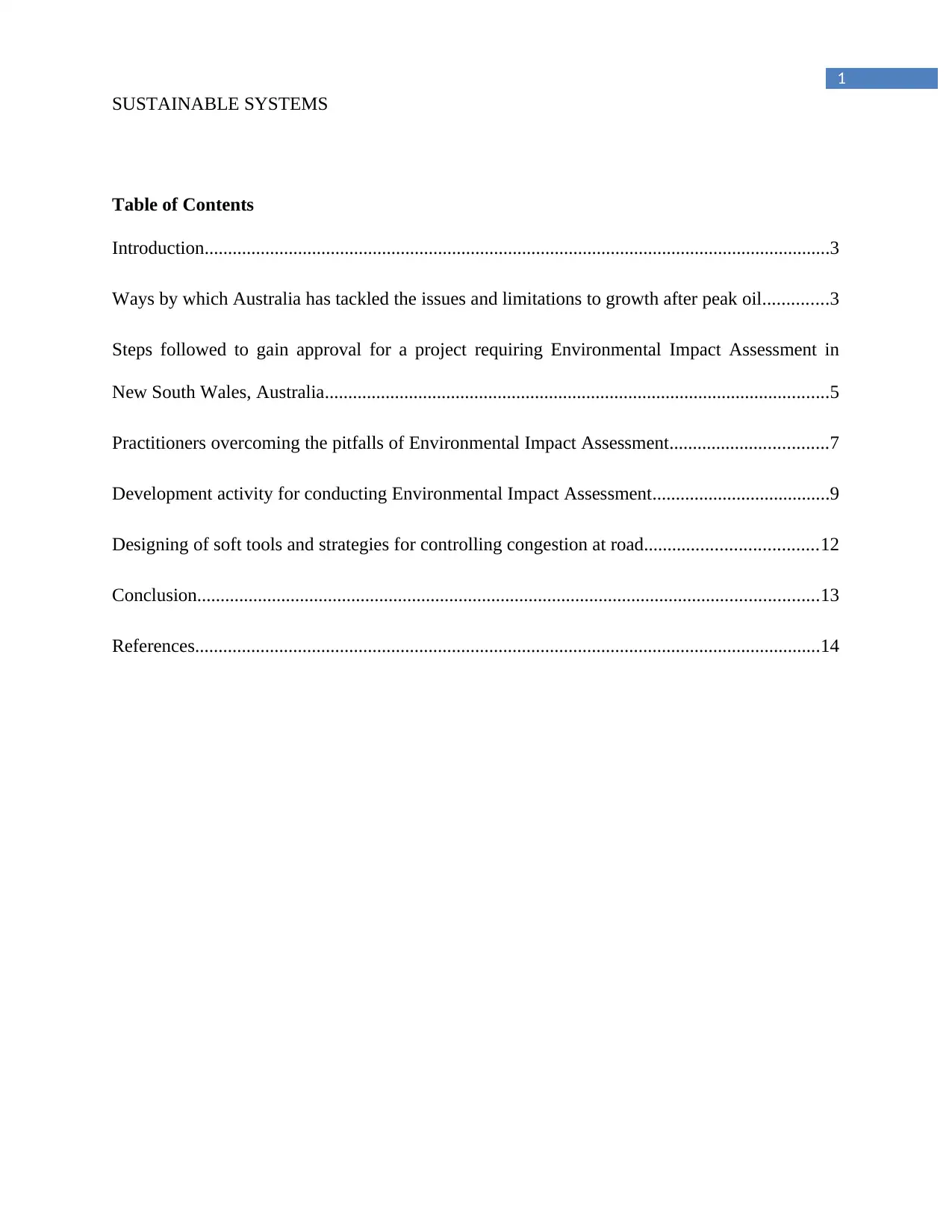
1
SUSTAINABLE SYSTEMS
Table of Contents
Introduction......................................................................................................................................3
Ways by which Australia has tackled the issues and limitations to growth after peak oil..............3
Steps followed to gain approval for a project requiring Environmental Impact Assessment in
New South Wales, Australia............................................................................................................5
Practitioners overcoming the pitfalls of Environmental Impact Assessment..................................7
Development activity for conducting Environmental Impact Assessment......................................9
Designing of soft tools and strategies for controlling congestion at road.....................................12
Conclusion.....................................................................................................................................13
References......................................................................................................................................14
SUSTAINABLE SYSTEMS
Table of Contents
Introduction......................................................................................................................................3
Ways by which Australia has tackled the issues and limitations to growth after peak oil..............3
Steps followed to gain approval for a project requiring Environmental Impact Assessment in
New South Wales, Australia............................................................................................................5
Practitioners overcoming the pitfalls of Environmental Impact Assessment..................................7
Development activity for conducting Environmental Impact Assessment......................................9
Designing of soft tools and strategies for controlling congestion at road.....................................12
Conclusion.....................................................................................................................................13
References......................................................................................................................................14
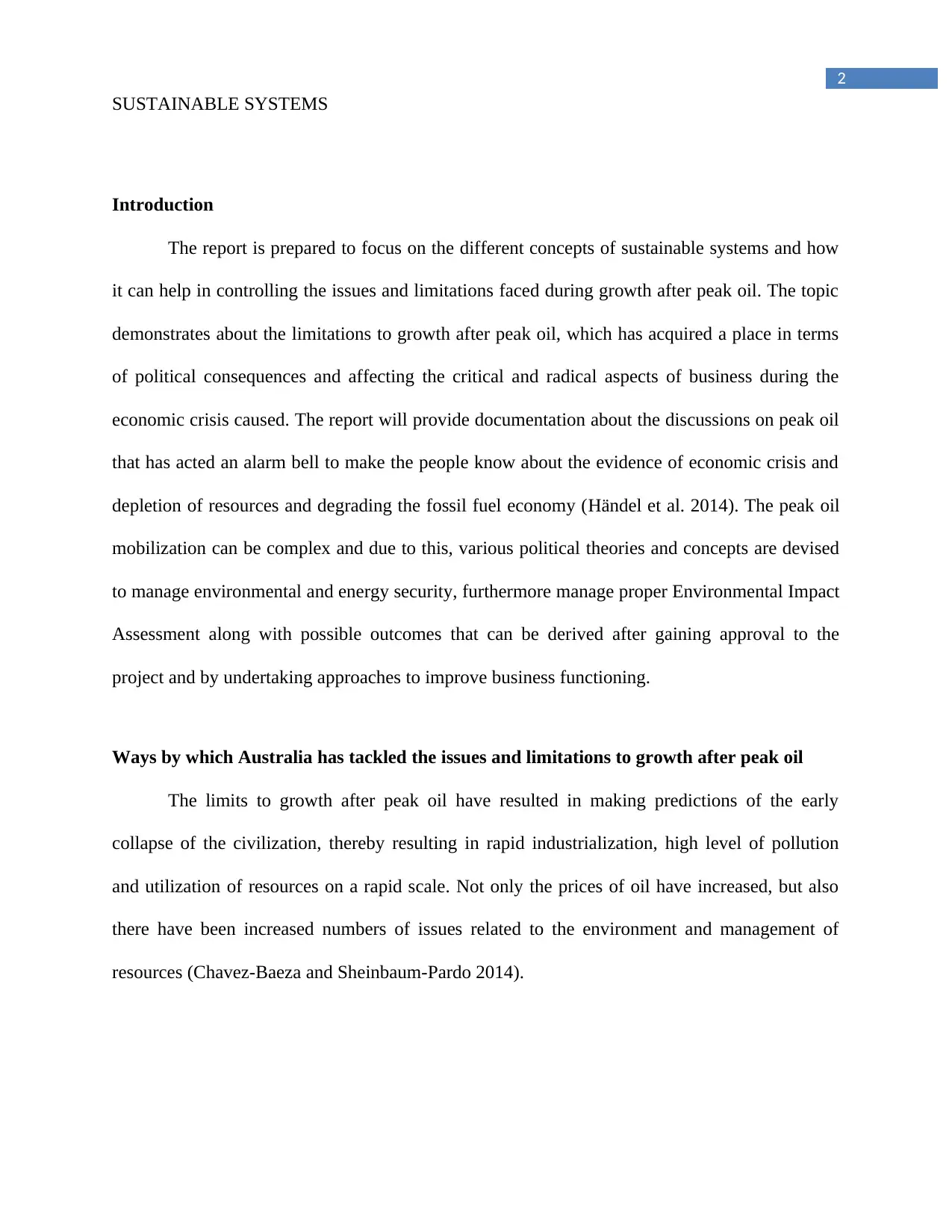
2
SUSTAINABLE SYSTEMS
Introduction
The report is prepared to focus on the different concepts of sustainable systems and how
it can help in controlling the issues and limitations faced during growth after peak oil. The topic
demonstrates about the limitations to growth after peak oil, which has acquired a place in terms
of political consequences and affecting the critical and radical aspects of business during the
economic crisis caused. The report will provide documentation about the discussions on peak oil
that has acted an alarm bell to make the people know about the evidence of economic crisis and
depletion of resources and degrading the fossil fuel economy (Händel et al. 2014). The peak oil
mobilization can be complex and due to this, various political theories and concepts are devised
to manage environmental and energy security, furthermore manage proper Environmental Impact
Assessment along with possible outcomes that can be derived after gaining approval to the
project and by undertaking approaches to improve business functioning.
Ways by which Australia has tackled the issues and limitations to growth after peak oil
The limits to growth after peak oil have resulted in making predictions of the early
collapse of the civilization, thereby resulting in rapid industrialization, high level of pollution
and utilization of resources on a rapid scale. Not only the prices of oil have increased, but also
there have been increased numbers of issues related to the environment and management of
resources (Chavez-Baeza and Sheinbaum-Pardo 2014).
SUSTAINABLE SYSTEMS
Introduction
The report is prepared to focus on the different concepts of sustainable systems and how
it can help in controlling the issues and limitations faced during growth after peak oil. The topic
demonstrates about the limitations to growth after peak oil, which has acquired a place in terms
of political consequences and affecting the critical and radical aspects of business during the
economic crisis caused. The report will provide documentation about the discussions on peak oil
that has acted an alarm bell to make the people know about the evidence of economic crisis and
depletion of resources and degrading the fossil fuel economy (Händel et al. 2014). The peak oil
mobilization can be complex and due to this, various political theories and concepts are devised
to manage environmental and energy security, furthermore manage proper Environmental Impact
Assessment along with possible outcomes that can be derived after gaining approval to the
project and by undertaking approaches to improve business functioning.
Ways by which Australia has tackled the issues and limitations to growth after peak oil
The limits to growth after peak oil have resulted in making predictions of the early
collapse of the civilization, thereby resulting in rapid industrialization, high level of pollution
and utilization of resources on a rapid scale. Not only the prices of oil have increased, but also
there have been increased numbers of issues related to the environment and management of
resources (Chavez-Baeza and Sheinbaum-Pardo 2014).
⊘ This is a preview!⊘
Do you want full access?
Subscribe today to unlock all pages.

Trusted by 1+ million students worldwide
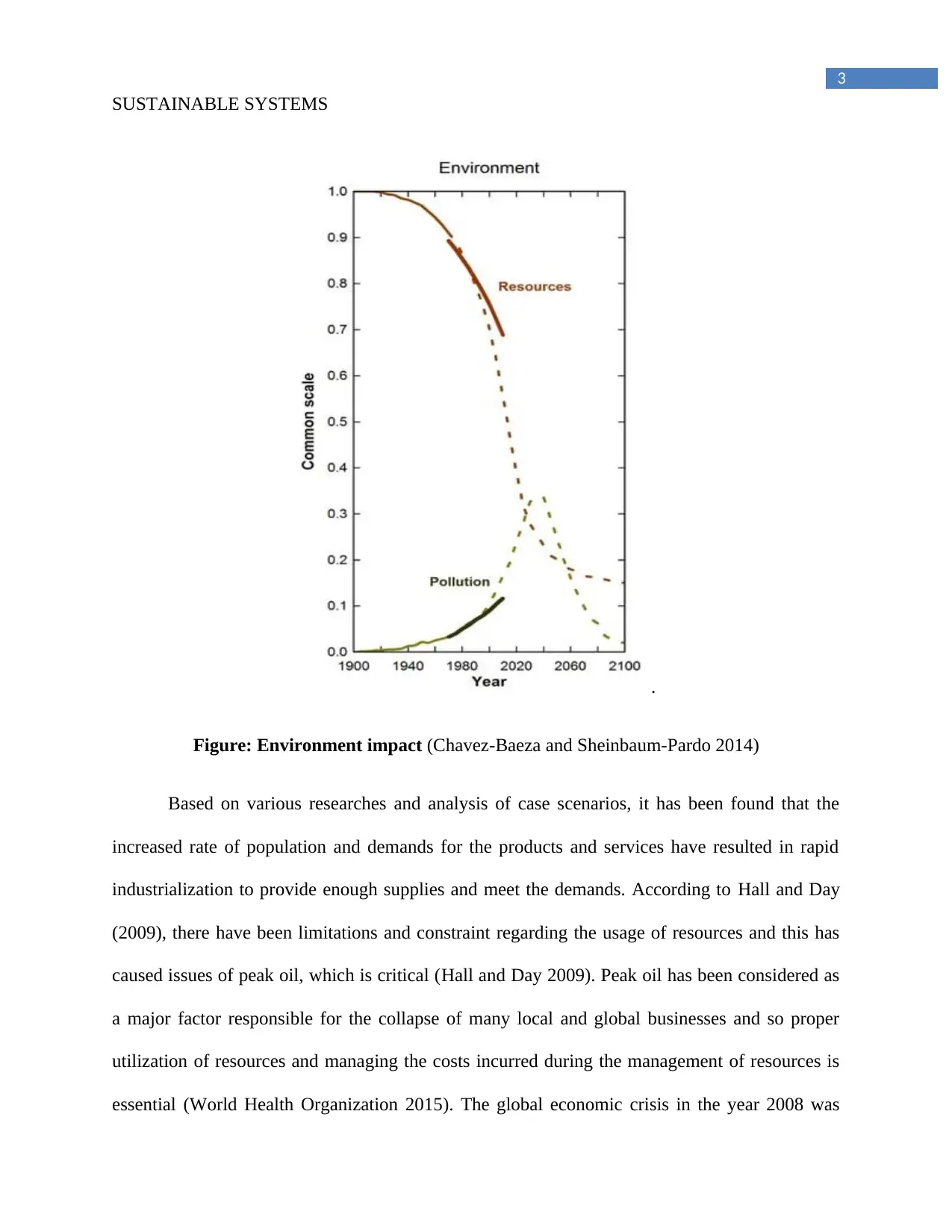
3
SUSTAINABLE SYSTEMS
.
Figure: Environment impact (Chavez-Baeza and Sheinbaum-Pardo 2014)
Based on various researches and analysis of case scenarios, it has been found that the
increased rate of population and demands for the products and services have resulted in rapid
industrialization to provide enough supplies and meet the demands. According to Hall and Day
(2009), there have been limitations and constraint regarding the usage of resources and this has
caused issues of peak oil, which is critical (Hall and Day 2009). Peak oil has been considered as
a major factor responsible for the collapse of many local and global businesses and so proper
utilization of resources and managing the costs incurred during the management of resources is
essential (World Health Organization 2015). The global economic crisis in the year 2008 was
SUSTAINABLE SYSTEMS
.
Figure: Environment impact (Chavez-Baeza and Sheinbaum-Pardo 2014)
Based on various researches and analysis of case scenarios, it has been found that the
increased rate of population and demands for the products and services have resulted in rapid
industrialization to provide enough supplies and meet the demands. According to Hall and Day
(2009), there have been limitations and constraint regarding the usage of resources and this has
caused issues of peak oil, which is critical (Hall and Day 2009). Peak oil has been considered as
a major factor responsible for the collapse of many local and global businesses and so proper
utilization of resources and managing the costs incurred during the management of resources is
essential (World Health Organization 2015). The global economic crisis in the year 2008 was
Paraphrase This Document
Need a fresh take? Get an instant paraphrase of this document with our AI Paraphraser
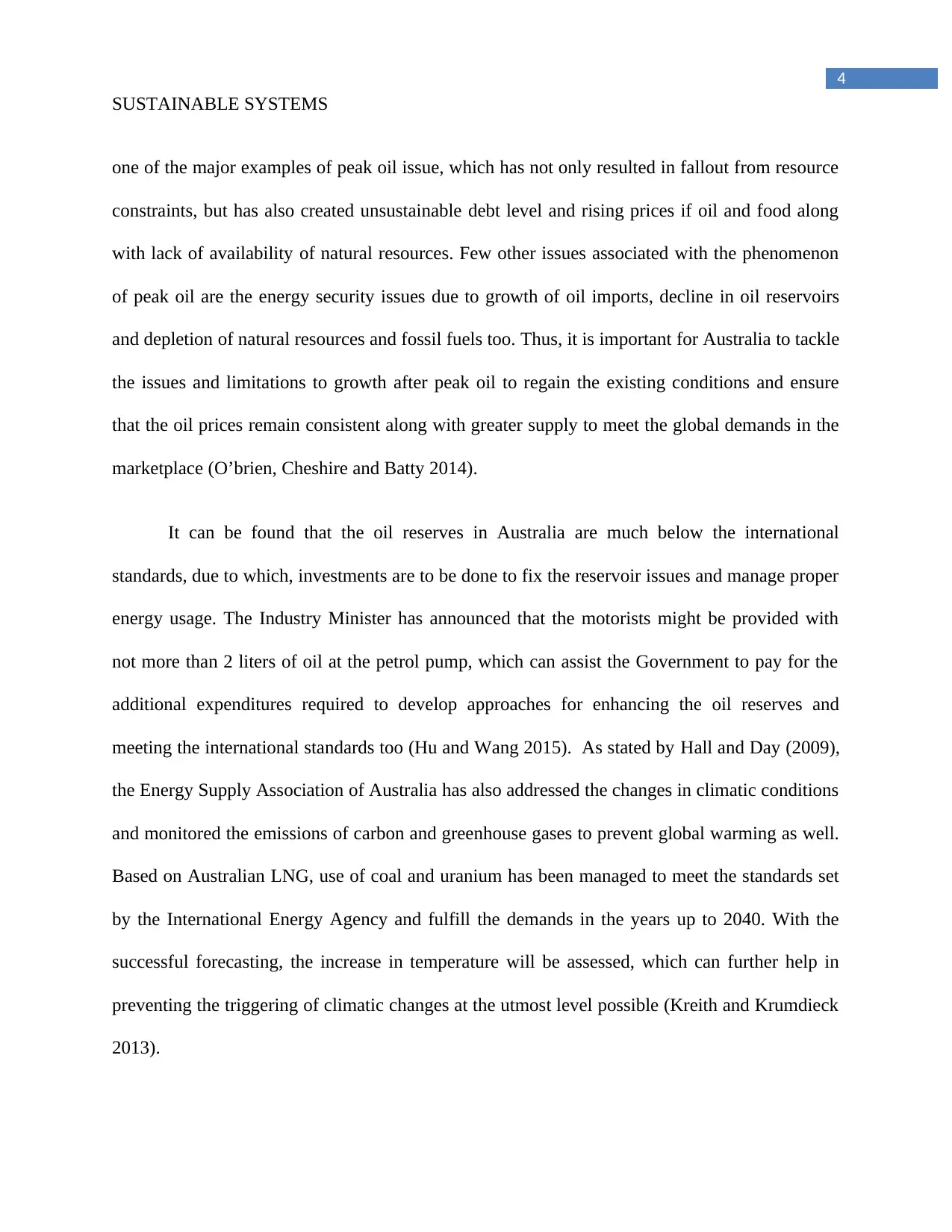
4
SUSTAINABLE SYSTEMS
one of the major examples of peak oil issue, which has not only resulted in fallout from resource
constraints, but has also created unsustainable debt level and rising prices if oil and food along
with lack of availability of natural resources. Few other issues associated with the phenomenon
of peak oil are the energy security issues due to growth of oil imports, decline in oil reservoirs
and depletion of natural resources and fossil fuels too. Thus, it is important for Australia to tackle
the issues and limitations to growth after peak oil to regain the existing conditions and ensure
that the oil prices remain consistent along with greater supply to meet the global demands in the
marketplace (O’brien, Cheshire and Batty 2014).
It can be found that the oil reserves in Australia are much below the international
standards, due to which, investments are to be done to fix the reservoir issues and manage proper
energy usage. The Industry Minister has announced that the motorists might be provided with
not more than 2 liters of oil at the petrol pump, which can assist the Government to pay for the
additional expenditures required to develop approaches for enhancing the oil reserves and
meeting the international standards too (Hu and Wang 2015). As stated by Hall and Day (2009),
the Energy Supply Association of Australia has also addressed the changes in climatic conditions
and monitored the emissions of carbon and greenhouse gases to prevent global warming as well.
Based on Australian LNG, use of coal and uranium has been managed to meet the standards set
by the International Energy Agency and fulfill the demands in the years up to 2040. With the
successful forecasting, the increase in temperature will be assessed, which can further help in
preventing the triggering of climatic changes at the utmost level possible (Kreith and Krumdieck
2013).
SUSTAINABLE SYSTEMS
one of the major examples of peak oil issue, which has not only resulted in fallout from resource
constraints, but has also created unsustainable debt level and rising prices if oil and food along
with lack of availability of natural resources. Few other issues associated with the phenomenon
of peak oil are the energy security issues due to growth of oil imports, decline in oil reservoirs
and depletion of natural resources and fossil fuels too. Thus, it is important for Australia to tackle
the issues and limitations to growth after peak oil to regain the existing conditions and ensure
that the oil prices remain consistent along with greater supply to meet the global demands in the
marketplace (O’brien, Cheshire and Batty 2014).
It can be found that the oil reserves in Australia are much below the international
standards, due to which, investments are to be done to fix the reservoir issues and manage proper
energy usage. The Industry Minister has announced that the motorists might be provided with
not more than 2 liters of oil at the petrol pump, which can assist the Government to pay for the
additional expenditures required to develop approaches for enhancing the oil reserves and
meeting the international standards too (Hu and Wang 2015). As stated by Hall and Day (2009),
the Energy Supply Association of Australia has also addressed the changes in climatic conditions
and monitored the emissions of carbon and greenhouse gases to prevent global warming as well.
Based on Australian LNG, use of coal and uranium has been managed to meet the standards set
by the International Energy Agency and fulfill the demands in the years up to 2040. With the
successful forecasting, the increase in temperature will be assessed, which can further help in
preventing the triggering of climatic changes at the utmost level possible (Kreith and Krumdieck
2013).
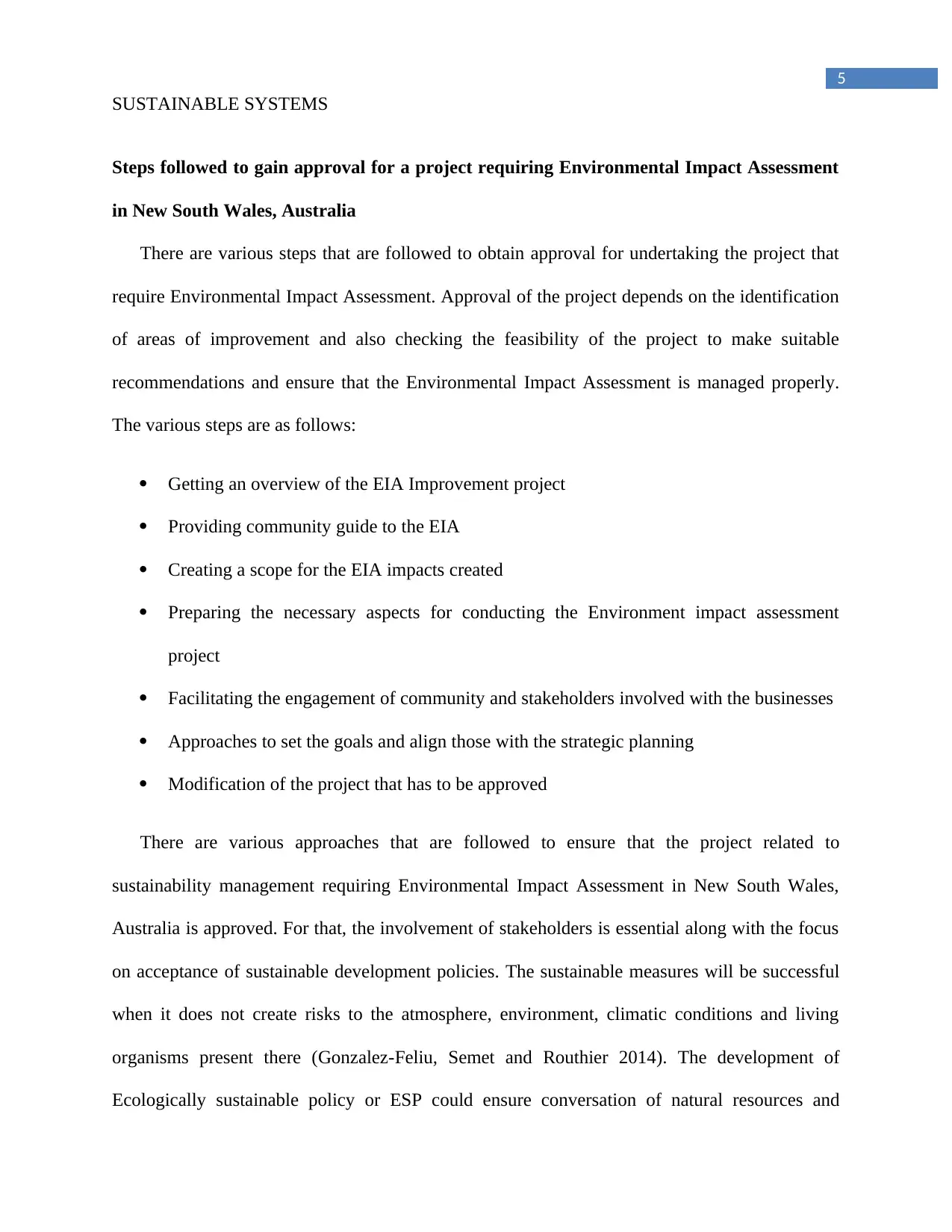
5
SUSTAINABLE SYSTEMS
Steps followed to gain approval for a project requiring Environmental Impact Assessment
in New South Wales, Australia
There are various steps that are followed to obtain approval for undertaking the project that
require Environmental Impact Assessment. Approval of the project depends on the identification
of areas of improvement and also checking the feasibility of the project to make suitable
recommendations and ensure that the Environmental Impact Assessment is managed properly.
The various steps are as follows:
Getting an overview of the EIA Improvement project
Providing community guide to the EIA
Creating a scope for the EIA impacts created
Preparing the necessary aspects for conducting the Environment impact assessment
project
Facilitating the engagement of community and stakeholders involved with the businesses
Approaches to set the goals and align those with the strategic planning
Modification of the project that has to be approved
There are various approaches that are followed to ensure that the project related to
sustainability management requiring Environmental Impact Assessment in New South Wales,
Australia is approved. For that, the involvement of stakeholders is essential along with the focus
on acceptance of sustainable development policies. The sustainable measures will be successful
when it does not create risks to the atmosphere, environment, climatic conditions and living
organisms present there (Gonzalez-Feliu, Semet and Routhier 2014). The development of
Ecologically sustainable policy or ESP could ensure conversation of natural resources and
SUSTAINABLE SYSTEMS
Steps followed to gain approval for a project requiring Environmental Impact Assessment
in New South Wales, Australia
There are various steps that are followed to obtain approval for undertaking the project that
require Environmental Impact Assessment. Approval of the project depends on the identification
of areas of improvement and also checking the feasibility of the project to make suitable
recommendations and ensure that the Environmental Impact Assessment is managed properly.
The various steps are as follows:
Getting an overview of the EIA Improvement project
Providing community guide to the EIA
Creating a scope for the EIA impacts created
Preparing the necessary aspects for conducting the Environment impact assessment
project
Facilitating the engagement of community and stakeholders involved with the businesses
Approaches to set the goals and align those with the strategic planning
Modification of the project that has to be approved
There are various approaches that are followed to ensure that the project related to
sustainability management requiring Environmental Impact Assessment in New South Wales,
Australia is approved. For that, the involvement of stakeholders is essential along with the focus
on acceptance of sustainable development policies. The sustainable measures will be successful
when it does not create risks to the atmosphere, environment, climatic conditions and living
organisms present there (Gonzalez-Feliu, Semet and Routhier 2014). The development of
Ecologically sustainable policy or ESP could ensure conversation of natural resources and
⊘ This is a preview!⊘
Do you want full access?
Subscribe today to unlock all pages.

Trusted by 1+ million students worldwide
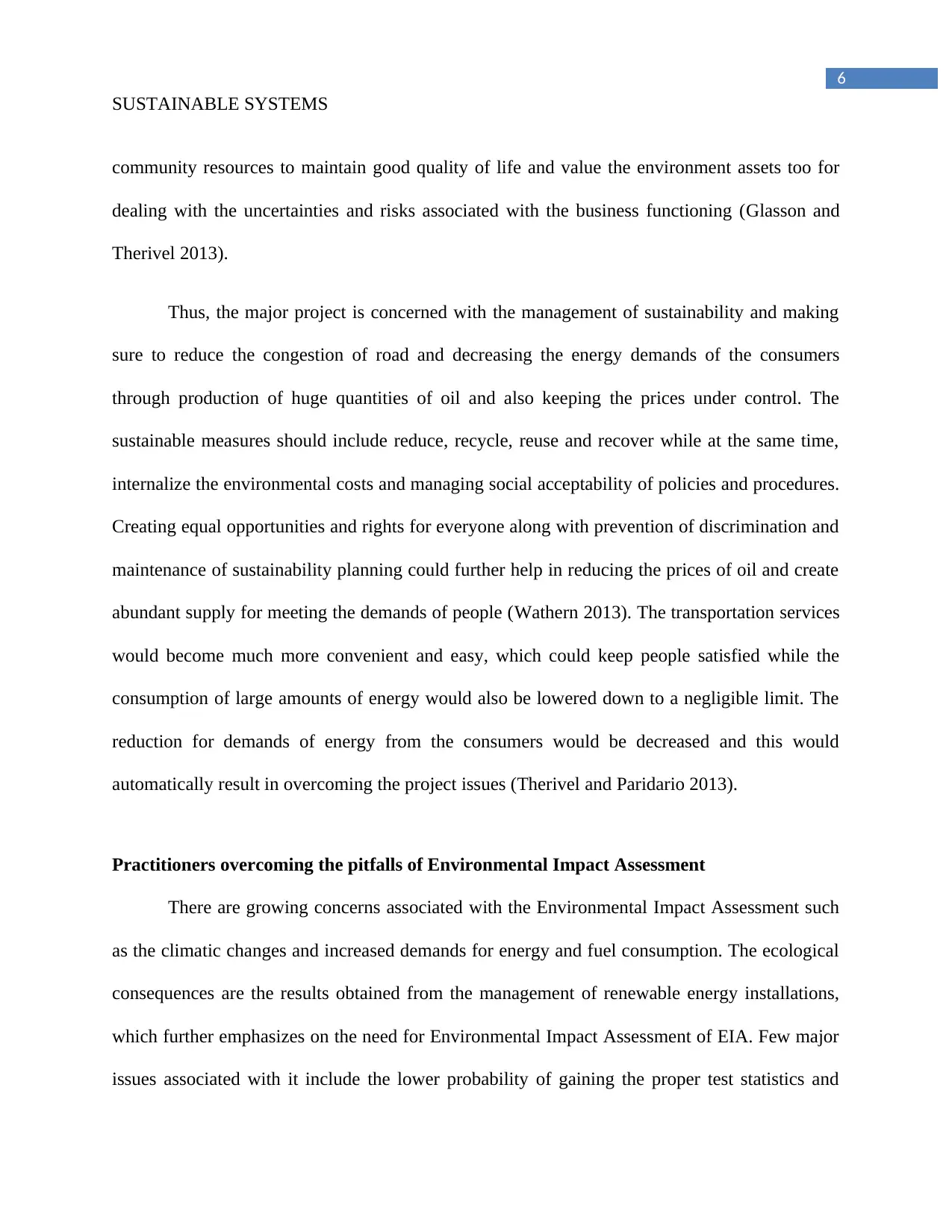
6
SUSTAINABLE SYSTEMS
community resources to maintain good quality of life and value the environment assets too for
dealing with the uncertainties and risks associated with the business functioning (Glasson and
Therivel 2013).
Thus, the major project is concerned with the management of sustainability and making
sure to reduce the congestion of road and decreasing the energy demands of the consumers
through production of huge quantities of oil and also keeping the prices under control. The
sustainable measures should include reduce, recycle, reuse and recover while at the same time,
internalize the environmental costs and managing social acceptability of policies and procedures.
Creating equal opportunities and rights for everyone along with prevention of discrimination and
maintenance of sustainability planning could further help in reducing the prices of oil and create
abundant supply for meeting the demands of people (Wathern 2013). The transportation services
would become much more convenient and easy, which could keep people satisfied while the
consumption of large amounts of energy would also be lowered down to a negligible limit. The
reduction for demands of energy from the consumers would be decreased and this would
automatically result in overcoming the project issues (Therivel and Paridario 2013).
Practitioners overcoming the pitfalls of Environmental Impact Assessment
There are growing concerns associated with the Environmental Impact Assessment such
as the climatic changes and increased demands for energy and fuel consumption. The ecological
consequences are the results obtained from the management of renewable energy installations,
which further emphasizes on the need for Environmental Impact Assessment of EIA. Few major
issues associated with it include the lower probability of gaining the proper test statistics and
SUSTAINABLE SYSTEMS
community resources to maintain good quality of life and value the environment assets too for
dealing with the uncertainties and risks associated with the business functioning (Glasson and
Therivel 2013).
Thus, the major project is concerned with the management of sustainability and making
sure to reduce the congestion of road and decreasing the energy demands of the consumers
through production of huge quantities of oil and also keeping the prices under control. The
sustainable measures should include reduce, recycle, reuse and recover while at the same time,
internalize the environmental costs and managing social acceptability of policies and procedures.
Creating equal opportunities and rights for everyone along with prevention of discrimination and
maintenance of sustainability planning could further help in reducing the prices of oil and create
abundant supply for meeting the demands of people (Wathern 2013). The transportation services
would become much more convenient and easy, which could keep people satisfied while the
consumption of large amounts of energy would also be lowered down to a negligible limit. The
reduction for demands of energy from the consumers would be decreased and this would
automatically result in overcoming the project issues (Therivel and Paridario 2013).
Practitioners overcoming the pitfalls of Environmental Impact Assessment
There are growing concerns associated with the Environmental Impact Assessment such
as the climatic changes and increased demands for energy and fuel consumption. The ecological
consequences are the results obtained from the management of renewable energy installations,
which further emphasizes on the need for Environmental Impact Assessment of EIA. Few major
issues associated with it include the lower probability of gaining the proper test statistics and
Paraphrase This Document
Need a fresh take? Get an instant paraphrase of this document with our AI Paraphraser
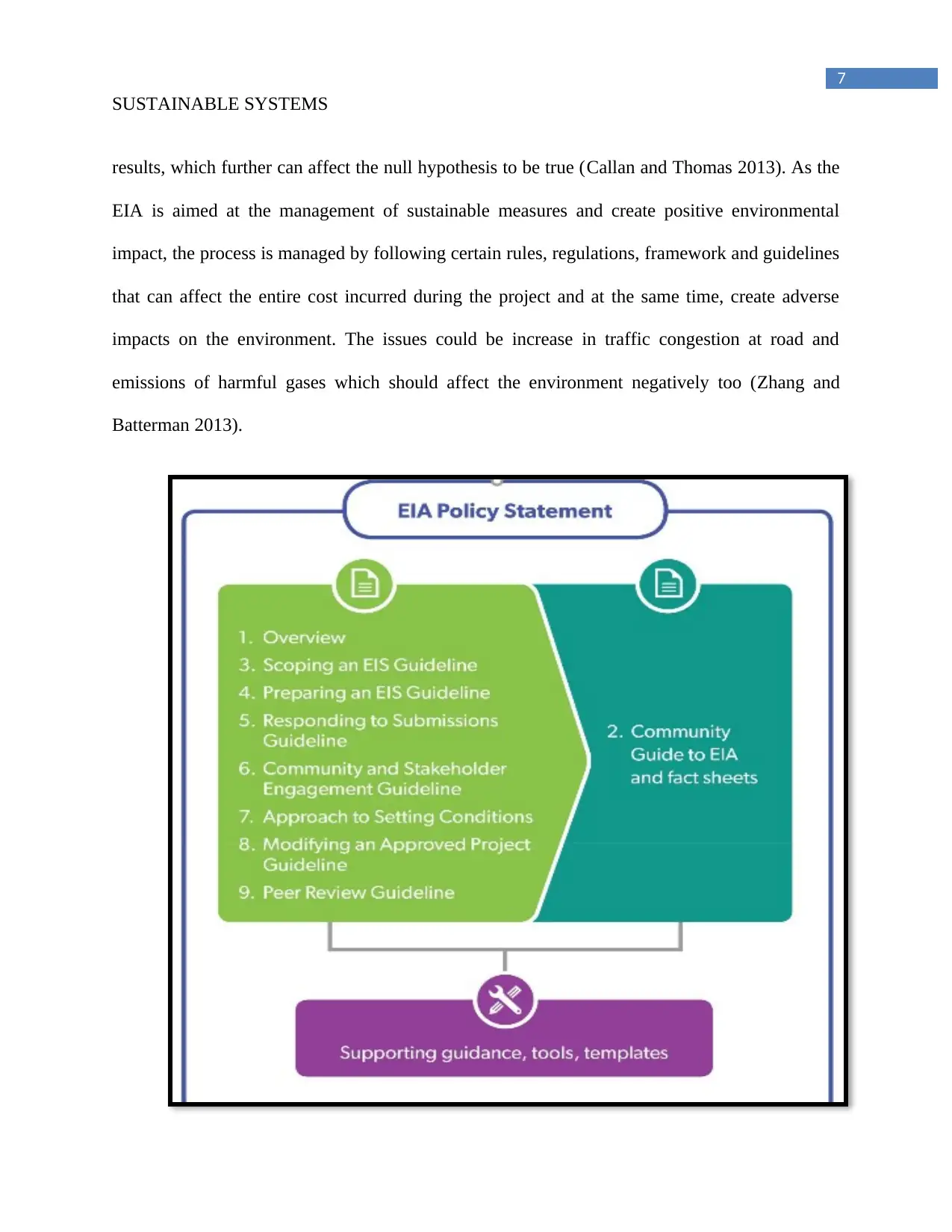
7
SUSTAINABLE SYSTEMS
results, which further can affect the null hypothesis to be true (Callan and Thomas 2013). As the
EIA is aimed at the management of sustainable measures and create positive environmental
impact, the process is managed by following certain rules, regulations, framework and guidelines
that can affect the entire cost incurred during the project and at the same time, create adverse
impacts on the environment. The issues could be increase in traffic congestion at road and
emissions of harmful gases which should affect the environment negatively too (Zhang and
Batterman 2013).
SUSTAINABLE SYSTEMS
results, which further can affect the null hypothesis to be true (Callan and Thomas 2013). As the
EIA is aimed at the management of sustainable measures and create positive environmental
impact, the process is managed by following certain rules, regulations, framework and guidelines
that can affect the entire cost incurred during the project and at the same time, create adverse
impacts on the environment. The issues could be increase in traffic congestion at road and
emissions of harmful gases which should affect the environment negatively too (Zhang and
Batterman 2013).
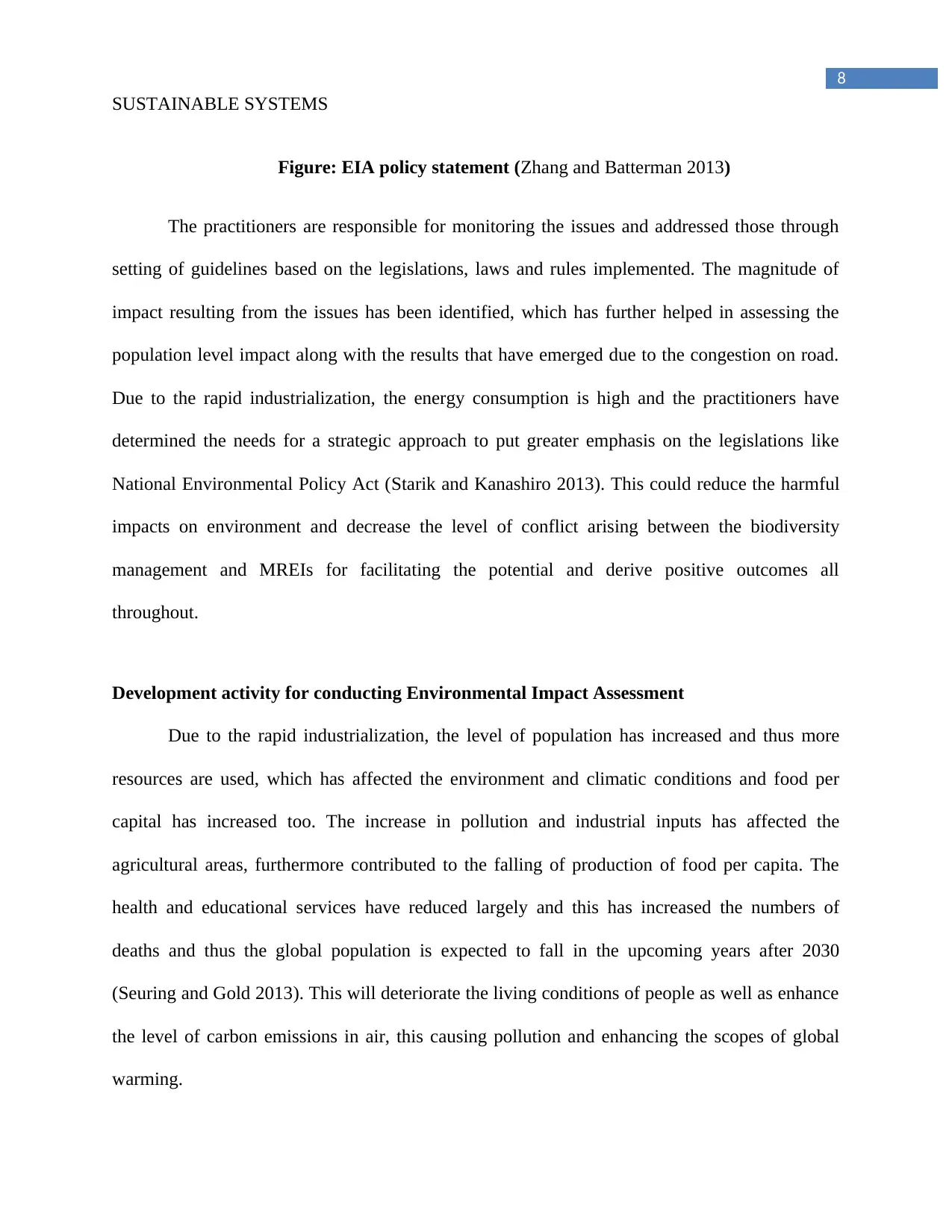
8
SUSTAINABLE SYSTEMS
Figure: EIA policy statement (Zhang and Batterman 2013)
The practitioners are responsible for monitoring the issues and addressed those through
setting of guidelines based on the legislations, laws and rules implemented. The magnitude of
impact resulting from the issues has been identified, which has further helped in assessing the
population level impact along with the results that have emerged due to the congestion on road.
Due to the rapid industrialization, the energy consumption is high and the practitioners have
determined the needs for a strategic approach to put greater emphasis on the legislations like
National Environmental Policy Act (Starik and Kanashiro 2013). This could reduce the harmful
impacts on environment and decrease the level of conflict arising between the biodiversity
management and MREIs for facilitating the potential and derive positive outcomes all
throughout.
Development activity for conducting Environmental Impact Assessment
Due to the rapid industrialization, the level of population has increased and thus more
resources are used, which has affected the environment and climatic conditions and food per
capital has increased too. The increase in pollution and industrial inputs has affected the
agricultural areas, furthermore contributed to the falling of production of food per capita. The
health and educational services have reduced largely and this has increased the numbers of
deaths and thus the global population is expected to fall in the upcoming years after 2030
(Seuring and Gold 2013). This will deteriorate the living conditions of people as well as enhance
the level of carbon emissions in air, this causing pollution and enhancing the scopes of global
warming.
SUSTAINABLE SYSTEMS
Figure: EIA policy statement (Zhang and Batterman 2013)
The practitioners are responsible for monitoring the issues and addressed those through
setting of guidelines based on the legislations, laws and rules implemented. The magnitude of
impact resulting from the issues has been identified, which has further helped in assessing the
population level impact along with the results that have emerged due to the congestion on road.
Due to the rapid industrialization, the energy consumption is high and the practitioners have
determined the needs for a strategic approach to put greater emphasis on the legislations like
National Environmental Policy Act (Starik and Kanashiro 2013). This could reduce the harmful
impacts on environment and decrease the level of conflict arising between the biodiversity
management and MREIs for facilitating the potential and derive positive outcomes all
throughout.
Development activity for conducting Environmental Impact Assessment
Due to the rapid industrialization, the level of population has increased and thus more
resources are used, which has affected the environment and climatic conditions and food per
capital has increased too. The increase in pollution and industrial inputs has affected the
agricultural areas, furthermore contributed to the falling of production of food per capita. The
health and educational services have reduced largely and this has increased the numbers of
deaths and thus the global population is expected to fall in the upcoming years after 2030
(Seuring and Gold 2013). This will deteriorate the living conditions of people as well as enhance
the level of carbon emissions in air, this causing pollution and enhancing the scopes of global
warming.
⊘ This is a preview!⊘
Do you want full access?
Subscribe today to unlock all pages.

Trusted by 1+ million students worldwide
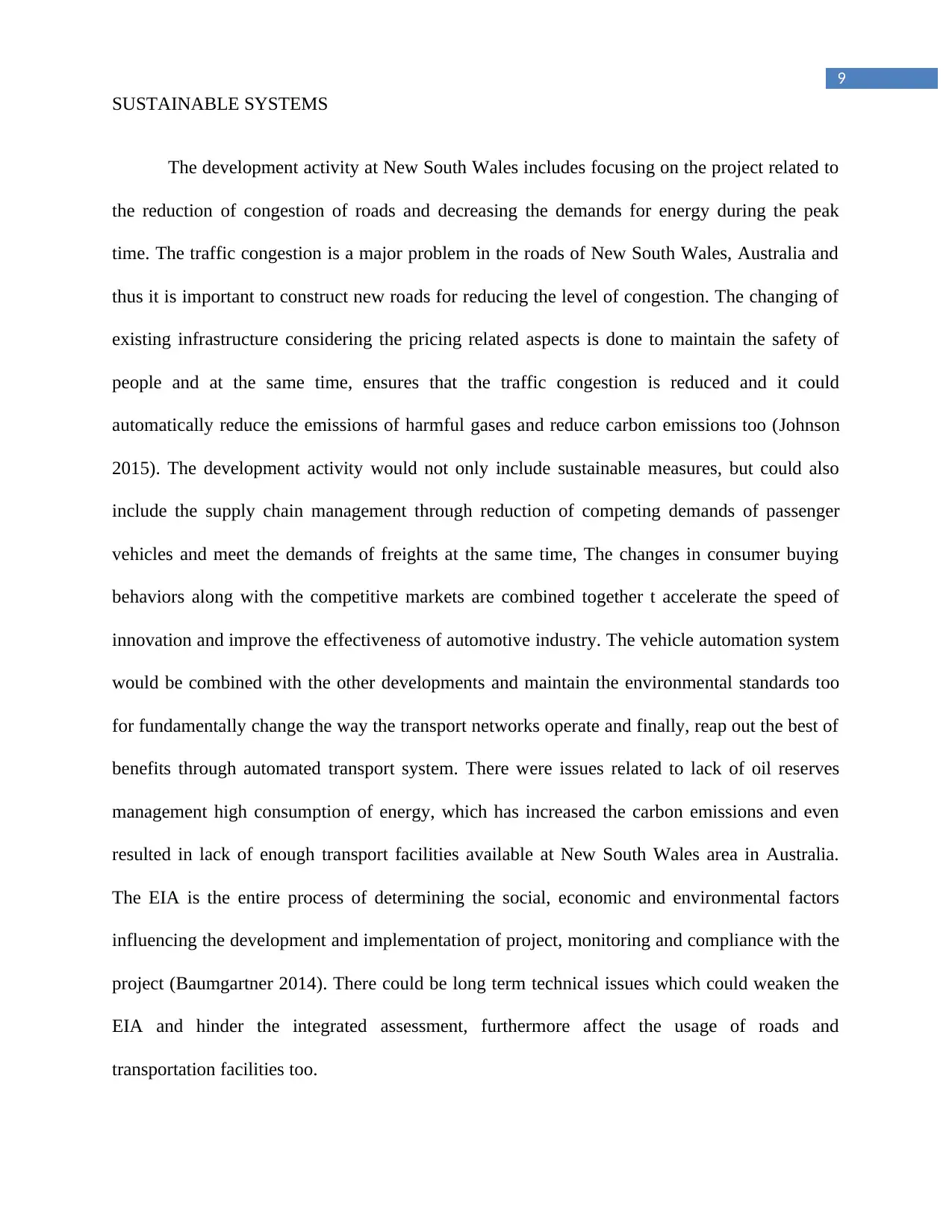
9
SUSTAINABLE SYSTEMS
The development activity at New South Wales includes focusing on the project related to
the reduction of congestion of roads and decreasing the demands for energy during the peak
time. The traffic congestion is a major problem in the roads of New South Wales, Australia and
thus it is important to construct new roads for reducing the level of congestion. The changing of
existing infrastructure considering the pricing related aspects is done to maintain the safety of
people and at the same time, ensures that the traffic congestion is reduced and it could
automatically reduce the emissions of harmful gases and reduce carbon emissions too (Johnson
2015). The development activity would not only include sustainable measures, but could also
include the supply chain management through reduction of competing demands of passenger
vehicles and meet the demands of freights at the same time, The changes in consumer buying
behaviors along with the competitive markets are combined together t accelerate the speed of
innovation and improve the effectiveness of automotive industry. The vehicle automation system
would be combined with the other developments and maintain the environmental standards too
for fundamentally change the way the transport networks operate and finally, reap out the best of
benefits through automated transport system. There were issues related to lack of oil reserves
management high consumption of energy, which has increased the carbon emissions and even
resulted in lack of enough transport facilities available at New South Wales area in Australia.
The EIA is the entire process of determining the social, economic and environmental factors
influencing the development and implementation of project, monitoring and compliance with the
project (Baumgartner 2014). There could be long term technical issues which could weaken the
EIA and hinder the integrated assessment, furthermore affect the usage of roads and
transportation facilities too.
SUSTAINABLE SYSTEMS
The development activity at New South Wales includes focusing on the project related to
the reduction of congestion of roads and decreasing the demands for energy during the peak
time. The traffic congestion is a major problem in the roads of New South Wales, Australia and
thus it is important to construct new roads for reducing the level of congestion. The changing of
existing infrastructure considering the pricing related aspects is done to maintain the safety of
people and at the same time, ensures that the traffic congestion is reduced and it could
automatically reduce the emissions of harmful gases and reduce carbon emissions too (Johnson
2015). The development activity would not only include sustainable measures, but could also
include the supply chain management through reduction of competing demands of passenger
vehicles and meet the demands of freights at the same time, The changes in consumer buying
behaviors along with the competitive markets are combined together t accelerate the speed of
innovation and improve the effectiveness of automotive industry. The vehicle automation system
would be combined with the other developments and maintain the environmental standards too
for fundamentally change the way the transport networks operate and finally, reap out the best of
benefits through automated transport system. There were issues related to lack of oil reserves
management high consumption of energy, which has increased the carbon emissions and even
resulted in lack of enough transport facilities available at New South Wales area in Australia.
The EIA is the entire process of determining the social, economic and environmental factors
influencing the development and implementation of project, monitoring and compliance with the
project (Baumgartner 2014). There could be long term technical issues which could weaken the
EIA and hinder the integrated assessment, furthermore affect the usage of roads and
transportation facilities too.
Paraphrase This Document
Need a fresh take? Get an instant paraphrase of this document with our AI Paraphraser
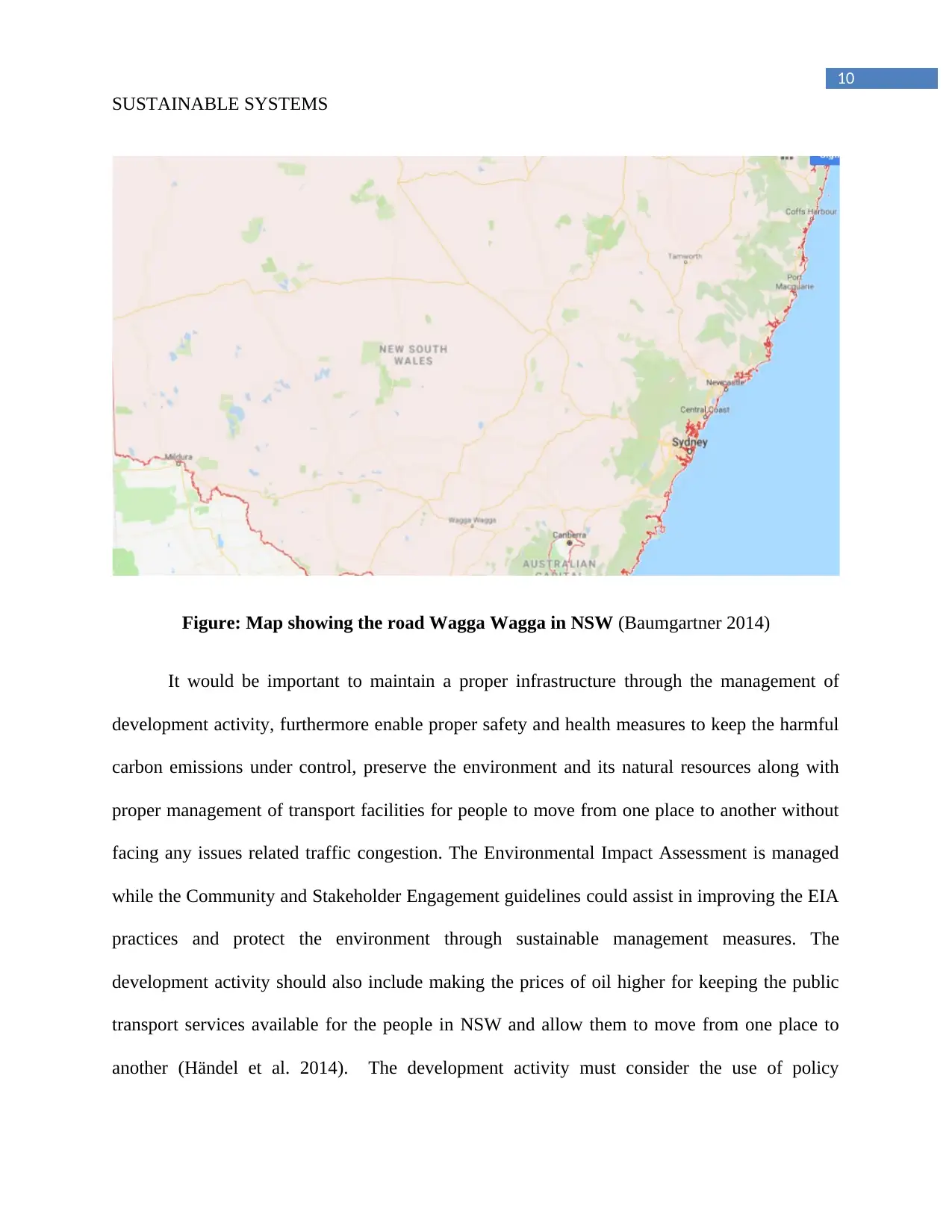
10
SUSTAINABLE SYSTEMS
Figure: Map showing the road Wagga Wagga in NSW (Baumgartner 2014)
It would be important to maintain a proper infrastructure through the management of
development activity, furthermore enable proper safety and health measures to keep the harmful
carbon emissions under control, preserve the environment and its natural resources along with
proper management of transport facilities for people to move from one place to another without
facing any issues related traffic congestion. The Environmental Impact Assessment is managed
while the Community and Stakeholder Engagement guidelines could assist in improving the EIA
practices and protect the environment through sustainable management measures. The
development activity should also include making the prices of oil higher for keeping the public
transport services available for the people in NSW and allow them to move from one place to
another (Händel et al. 2014). The development activity must consider the use of policy
SUSTAINABLE SYSTEMS
Figure: Map showing the road Wagga Wagga in NSW (Baumgartner 2014)
It would be important to maintain a proper infrastructure through the management of
development activity, furthermore enable proper safety and health measures to keep the harmful
carbon emissions under control, preserve the environment and its natural resources along with
proper management of transport facilities for people to move from one place to another without
facing any issues related traffic congestion. The Environmental Impact Assessment is managed
while the Community and Stakeholder Engagement guidelines could assist in improving the EIA
practices and protect the environment through sustainable management measures. The
development activity should also include making the prices of oil higher for keeping the public
transport services available for the people in NSW and allow them to move from one place to
another (Händel et al. 2014). The development activity must consider the use of policy
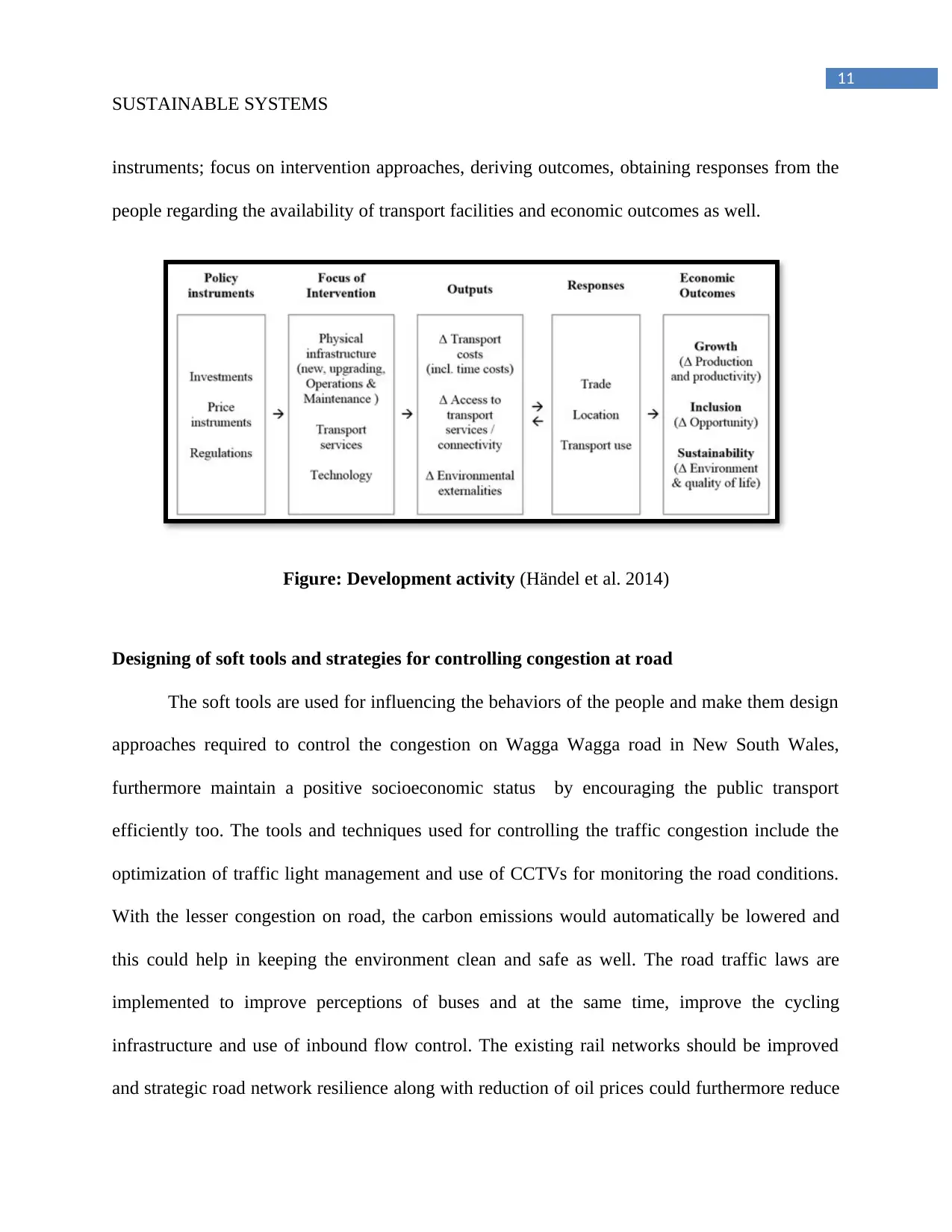
11
SUSTAINABLE SYSTEMS
instruments; focus on intervention approaches, deriving outcomes, obtaining responses from the
people regarding the availability of transport facilities and economic outcomes as well.
Figure: Development activity (Händel et al. 2014)
Designing of soft tools and strategies for controlling congestion at road
The soft tools are used for influencing the behaviors of the people and make them design
approaches required to control the congestion on Wagga Wagga road in New South Wales,
furthermore maintain a positive socioeconomic status by encouraging the public transport
efficiently too. The tools and techniques used for controlling the traffic congestion include the
optimization of traffic light management and use of CCTVs for monitoring the road conditions.
With the lesser congestion on road, the carbon emissions would automatically be lowered and
this could help in keeping the environment clean and safe as well. The road traffic laws are
implemented to improve perceptions of buses and at the same time, improve the cycling
infrastructure and use of inbound flow control. The existing rail networks should be improved
and strategic road network resilience along with reduction of oil prices could furthermore reduce
SUSTAINABLE SYSTEMS
instruments; focus on intervention approaches, deriving outcomes, obtaining responses from the
people regarding the availability of transport facilities and economic outcomes as well.
Figure: Development activity (Händel et al. 2014)
Designing of soft tools and strategies for controlling congestion at road
The soft tools are used for influencing the behaviors of the people and make them design
approaches required to control the congestion on Wagga Wagga road in New South Wales,
furthermore maintain a positive socioeconomic status by encouraging the public transport
efficiently too. The tools and techniques used for controlling the traffic congestion include the
optimization of traffic light management and use of CCTVs for monitoring the road conditions.
With the lesser congestion on road, the carbon emissions would automatically be lowered and
this could help in keeping the environment clean and safe as well. The road traffic laws are
implemented to improve perceptions of buses and at the same time, improve the cycling
infrastructure and use of inbound flow control. The existing rail networks should be improved
and strategic road network resilience along with reduction of oil prices could furthermore reduce
⊘ This is a preview!⊘
Do you want full access?
Subscribe today to unlock all pages.

Trusted by 1+ million students worldwide
1 out of 15
Related Documents
Your All-in-One AI-Powered Toolkit for Academic Success.
+13062052269
info@desklib.com
Available 24*7 on WhatsApp / Email
![[object Object]](/_next/static/media/star-bottom.7253800d.svg)
Unlock your academic potential
Copyright © 2020–2025 A2Z Services. All Rights Reserved. Developed and managed by ZUCOL.




